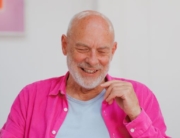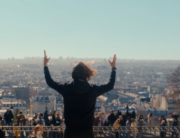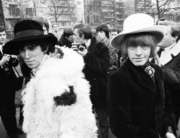
Harry Belafonte in HAVA NAGILA (THE MOVIE) (International Film Circuit)
Hava Nagila (The Movie) entertainingly traces the origins of the ubiquitous song and how it became worldwide kitsch. The global popularity of the song is made abundantly clear, but most intriguing is the background on its genesis and popularization through interviews with the expected experts, such as ethnomusicologists, to the surprising spreaders of its infectiously catchy, optimistic gospel.
Touring the ruins of a Hasidic center in Sadagora, Ukraine, director Roberta Grossman comes upon a group of British yeshiva boys led by the great-great-great-grandson namesake of Rabbi Yisroel Friedman, who wrote the original melody in the 1840’s as a niggun, a chanted, wordless prayer. He explains that the rabbi’s dispersed followers carried the melody to Palestine around World War I. There it was one of many immigrant melodies collected and transcribed by Abraham Zvi Idelsohn, the founding force in Jewish musicology, as described by his family. But with the announcement that the documentary would be following the conventional wisdom of attributing the addition of the lyrics to Idelsohn, the family of Cantor Moshe Nathanson came forward with a convincing challenge, saying he wrote the lyrics in 1915 as an assignment in Idelsohn’s class. Both families agree that the key change was to speed up the song to make it a danceable melody.
Noted dancers and dance teachers in Israel discuss how circle dancing was promulgated at the kibbutzim to symbolize the pioneer egalitarian ethic, and the hora quickly became a standard image of their participatory entertainment after working together in the fields. It was this socialist connection, more than their Zionist fervor, that brought the song into Greenwich Village coffee houses, where, as Harry Belafonte describes, he first heard it as world folk music. His live recording of the song on a best-selling album helped carry it around the world. There’s also nostalgic interviews with Jewish and non-Jewish popularizers, including Glen Campbell and Connie Francis, who drily says, “I’m 10 percent Jewish on my manager’s side.”
As a case study in the development of a cultural stereotype, the film goes on to include an astounding array of satires and deconstructions from music, TV, and the movies, some well known (by Bob Dylan and Allan Sherman),and out and out ridiculous performances in many languages, most evidently available for hours on YouTube. On the other foot, the seemingly endless home movies of the song and dance at American weddings and bar/bat mitzvahs from the 1950’s on get as wearyingly redundant like a party that has gone on way too long.
It’s only near the end that all the lyrics and English translation are provided, so that folks can finally know what they, and probably you, have been singing and dancing to all these years.






Leave A Comment